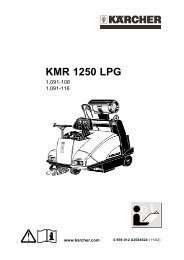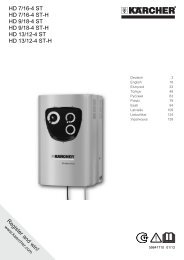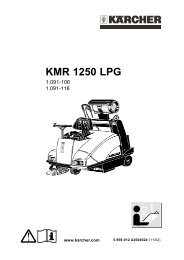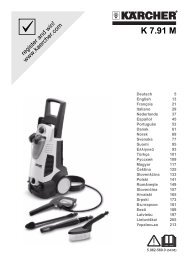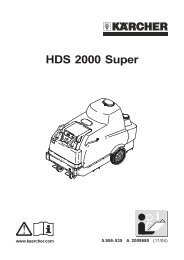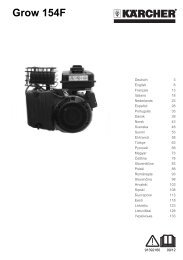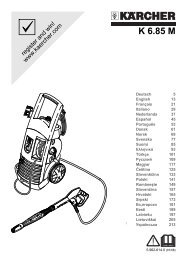HKF 200 - Karcher
HKF 200 - Karcher
HKF 200 - Karcher
You also want an ePaper? Increase the reach of your titles
YUMPU automatically turns print PDFs into web optimized ePapers that Google loves.
Zone layout<br />
Special conditions in the Ex area<br />
Areas that bear the risk of explosion are divided<br />
into zones, according to the frequency<br />
and duration of explosion-risk<br />
atmosphere in BetrSichV and EN 1127-1.<br />
The definition of the zones lies in the responsibility<br />
of the operator.<br />
Tips for zoning are included in the BetrSichV,<br />
EN 1127-1, BGR 104 – Ex-guideline<br />
of BG Chemie and in the EN 60079-10.<br />
– Zone 0<br />
Zone 0 is an area where dangerous explosion-risk<br />
atmosphere is present as a<br />
mixture of air and flammable gases, vapors<br />
or mists at all times, across long<br />
time periods or frequently.<br />
– Zone 1<br />
Zone 1 is an area where (during normal<br />
operation) dangerous explosion-risk atmosphere<br />
is present as a mixture of air<br />
and flammable gases, vapors or mists<br />
from time to time.<br />
– Zone 2<br />
Zone 2 is an area where (during normal<br />
operation) dangerous explosion-risk atmosphere<br />
as a mixture of air and flammable<br />
gases, vapors or mists is not<br />
normally present and if present, only for<br />
a short time.<br />
– Zone 20<br />
Zone 20 is an area where dangerous<br />
explosion-risk atmosphere is present as<br />
a cloud of flammable dust contained in<br />
the air, at all times, across long time periods<br />
or frequently.<br />
– Zone 21<br />
Zone 21 is an area where (during normal<br />
operation) dangerous explosionrisk<br />
atmosphere is present as a cloud of<br />
flammable dust in the air from time to<br />
time.<br />
– Zone 22<br />
Zone 22 is an area where (during normal<br />
operation) dangerous explosionrisk<br />
atmosphere as a cloud of flammable<br />
dust is not normally present and if<br />
present, only for a short time.<br />
1 The interior cleaner must only be used<br />
in Zone 0 if the containers are at least 3<br />
m in diameter with the usual container<br />
height or do not exceed a comparable<br />
container size.<br />
2 The mass content of non-diluted solid<br />
substances in the cleaning liquid must<br />
not exceed 1%.<br />
3 The interior cleaner must be ground<br />
electro-statically.<br />
4 The pump for the cleaning liquid must<br />
only be operated while it is filled with fluid.<br />
5 The nominal pressure of the pump must<br />
not exceed 5 MPa when operating with<br />
solvents.<br />
6 The flow volume of the pump must not<br />
exceed 50 l/m when operating with solvents.<br />
7 The compressed air motor oder the<br />
electric gear motor must only be operated<br />
once the interior cleaner has been<br />
filled with cleaning liquid.<br />
8 The speed of the cleaning head must<br />
not exceed 40 rpm.<br />
9 The operating temperature of the cleaning<br />
liquid water with cleaning agents<br />
must not must not exceed 95 °C.<br />
10 The operating temperature of the cleaning<br />
liquid solvents, brines and acids<br />
must not must not exceed 20 °C.<br />
11 The interior cleaner must be checked<br />
for flawless condition and smooth function<br />
after a certain operating time has<br />
passed (incl. drive motor for its concentrical<br />
position in relation to the gland,<br />
bearing bushings and drive-side seal for<br />
wear and tear and leakage). If applicable,<br />
a repair needs to be conducted.<br />
12 The interior cleaner must only be used<br />
with cleaning liquids and in such media,<br />
whose affect on the materials is not<br />
damaging.<br />
13 Cleaning liquids that contain flammable<br />
solvent particles, must comply with the<br />
ignition groups IIA and IIB. Solvents of<br />
the ignition group IIC must not be<br />
sprayed.<br />
14 The interior cleaner must not be constantly<br />
located in Zone 0, but only during<br />
the actual container cleaning. The<br />
operating guidelines as per BetrSichV<br />
as well as other national guidelines<br />
must be adhered to. Take into consideration,<br />
that the mixture of the container/<br />
interior cleaner brought into the container<br />
is not resistant to breakdown from<br />
flames.<br />
15 Hoses must be conductive (electrostatically)<br />
(resistance R < 1000 Ohm).<br />
16 Only cleaning agents with a conductivity<br />
G > 1000 pS/m may be used.<br />
17 All parts that touch media must be connected<br />
to the grounding system.<br />
22 English






